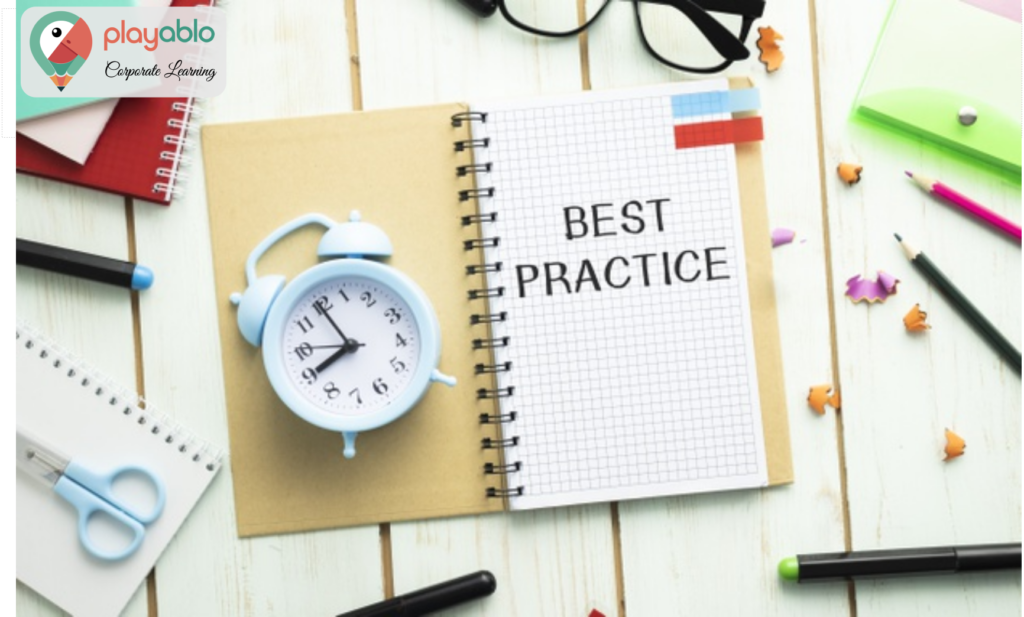Implementing best practices for assessments in eLearning — why is this crucial? “In keeping with a learner-centered approach, assessment should be part of the learning-teaching process, embedded in-class activities and in the interactions between learners and between learners and teachers” — Harasim, Hiltz, Teles, & Turoff.
This statement brings a transformative change to the preconceived notion of assessment-based learning. It is applicable even in the realm of online learning — if you want to infuse a system of a continuous learning culture in your organization. In short, to ensure eLearning success, a single exam at the end of each course is not sufficient. It would be best if you embedded assessments throughout each stage of your online training modules.

But before that, let’s understand why best practices for assessments are essential. Quantifiable assessments help you in measuring learning outcomes and ensuring course completions. It also enables you to estimate the percentage of the achievement of learning end-goals. In short, assessments ascertain the success of an eLearning platform. By aligning core employee competencies with relevant results, you make sure that your learners can practically apply the absorbed skills and knowledge in their required roles.
Now, coming back to our question — how to design the perfect strategy of best practices for assessments in your online course? As we already mentioned, simply incorporating a quiz at the culmination of a module and accompanying it with a passing score or certificate is inefficient. “Assessment MUST be an ongoing process and NOT an episodic occurrence.”
And to start designing your strategy on ‘how to assess training effectiveness’, you should first begin by understanding the different stages of assessments.
Table of Contents
The Different Stages of Assessments in Online Training
Formative Assessment

Formative assessment collects information throughout the online course; This is a continuous process where you collect data to improvise learning methodologies and enhance performance. One of the key elements of formative assessments is feedback — accompanying any tests — be it a quiz, a submission, or student participation rates in live classes and discussion forums.
Summative Assessment
One incorporates summative assessments at the end of a course — to help analyse if the trainees have achieved their end goals after the session. Typically, summative assessments come with a grade, score, or a reward. Some examples of this category of tests include performance tasks, a final quiz, or an exam — inserted after the conclusion of each micro-module (in case your LMS is designed for mobile-optimized micro-learning).
Ad: PlayAblo’s Enterprise-Grade Micro-Learning platform is built for the corporate learner. Micro-Learning, along with assessments and gamification features, ensures learning outcome measurement along with sustained engagement.
Find out more and request a custom demo!
Authentic Assessment
Authentic assessments are designed to include real-world scenarios in online learning. Some examples of authentic assessments are case studies and simulations. These activities ensure that trainees can apply their acquired knowledge in solving actual problems in a professional environment. They additionally allow learners to reflect on what they have learned while engaging and participating in activities.
Integrating the Three Assessment Stages in an Online Course

To ensure eLearning success, you must design a course which entwines formative, summative, and authentic assessments. By integrating assessment activities in different course segments, you provide continuous feedback and keep learners updated on their own progress.
You can get started by embedding questionnaires, reward-based quizzes, gamified tests, or mini-scored- exams in several parts of your module. The results?
Ad: PlayAblo’s Enterprise-Grade Micro-Learning platform is built for the corporate learner. Micro-Learning, along with assessments and gamification features, ensures learning outcome measurement along with sustained engagement.
Find out more and request a custom demo!
You will be continually informed about your learners’ engagement and participation rates. You will have access to quantifiable measures of your trainees’ progress while they take the course. You will additionally have the opportunity to identify skill gaps as your employees apply their knowledge in simulated problems.
So how do you incorporate all of the above aspects into your ‘how to assess training effectiveness’ strategy? Our step-by-step guide will help you get started in the right direction!
4 Best Practices for Assessments to Design the Perfect eLearning Strategy

A Defined Link Between Assessments and Learning Objectives
Among the first best practices for assessments is that each course of your eLearning platform MUST have some targeted objectives. You cannot simply design a curriculum with vague end goals. Now, curate specific assessment activities for each objective. If your learning goals are measurable, creating assessments based on them should be simple.
Assessments in Different Sections of the eLearning Module
The second best practices for assessments is — you should include assessments in every part of your course. At the beginning of a curriculum, you can add a quiz to test the existing knowledge of your employees. The questionnaires can comprise of related questions that introduce the subject.
Learners are motivated to learn more when they implement their background knowledge on a new topic. Or, you can embed response quizzes where learners can enter ideas about what they want the course to cover. This activity will reinforce inclusivity and propel trainees to dive deeper into the subject.
The next step is to incorporate assessments throughout the course. These tests MUST be accompanied by feedback. You can use an LMS that sends notifications whenever learners complete an assignment or whenever instructors provide feedback.
Finally, the assessment at the end of your course should include questions from each section of the syllabus. Summative assessments can be in the form of questionnaires, graded assignments, questions within videos, and discussion posts.
Framing the Right Questions

Outcomes and learning activities are designed to help learners enhance their basic knowledge and apply the advanced concepts in a professional setting. This is the third best practices for assessments. In short, training modules are created to up the skill level of employees. Therefore, the questions in your assessments should be created to address this jump — from lower-order to higher-order skills.
One ideal way to frame the perfect question set is by using Bloom’s Taxonomy — “A set of three hierarchical models used to classify educational learning objectives into levels of complexity and specificity. The three lists cover the learning objectives in cognitive, affective, and sensory domains.” You can also check out this excellent article that deeply dives into understanding Bloom’s Taxonomy.
Self-Assessments
Self-reflection and assessment are vital to creating a learner-focused environment. It counts as the fourth and final best practices for assessments. You can embed self-assessment techniques in your eLearning modules by communicating your expectations or objectives at the onset of the course. You may even think of a reflective diary where learners can record their experiences while taking the online class.
Conclusion
Whenever you design best practices for assessments, you should strive to gauge the competencies of your learners and NOT their memory. Make sure that at the end of the assessments, your employees develop a sense of confidence.
And even if learners do not have prior knowledge about a subject, motivate them by sharing a response questionnaire. In the midst of the course, boost engagement levels by celebrating milestones and including rewards. Finally, do not concentrate only on course completion rates when creating a plan for ‘how to assess training effectiveness’. Learning should be able to establish what your employees CAN do and NOT what they can recap!







5 Comments
Comments are closed, but trackbacks and pingbacks are open.